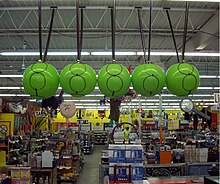Newton's cradle

Newton's cradle otherwise known as tanners balls, named after Sir Isaac Newton, is a device that demonstrates conservation of momentum and energy. The device is also known as an executive ball clicker, or balance balls.
Construction
The animated image above shows a typical Newton's cradle; a series of identically sized metal balls suspended in a metal frame so that they are just touching each other at rest. Each ball is attached to the frame by two wires of equal length angled away from each other. This restricts the pendulums' movements to the same plane.
Action
If one ball is pulled away and released, it falls and appears to come to a dead stop on hitting the other balls. The ball on the opposite side of the series appears to instantly acquire the speed of the first ball and swings in an arc that one would expect of the first ball.
The first time observer may find this visually intriguing and counter-intuitive. If a person charged into one end of a row of adjacent people then one would intuitively expect the whole row of people to be moved, rather than the last person in the row to acquire the kinetic energy.
The intermediate balls appear stationary. In fact, the cradle continues to work even if the intermediate balls are physically clamped still. This is also counter intuitive - transmitting motion without moving.
What actually happens is that the first impact produces a shock wave that propagates through the intermediate balls. A hard material such as steel is very good at doing this, where common objects like people in a bus queue are not.
The shock wave travels at the speed of sound in the medium. The speed of sound in steel is much faster (around 4699 m/s) than in air (around 343 m/s). The time to travel a few centimetres is too small for human perception, and so is the physical distortion of the balls as the shock wave passes through them.
In the real world, none of these processes has perfect efficiency. Energy is lost in the suspending wires, friction of the surrounding air, and sound. The last is obvious as the clicking of the balls can be heard. Toward the end of oscillation, even the intermediate balls are jiggling a bit.
Further intrigue is provided by starting more than one ball in motion. With two balls, exactly two balls on the opposite side swing out and back. While this is satisfyingly symmetrical, why could not one opposite ball swing out twice as fast, or four balls at quarter speed? Having the same number of balls swing on each side conserves both energy and momentum.
More than half the balls can be set in motion - for example 3 of 5 will result in the central ball swinging without abrupt cessation or resumption of motion.
Further physics
The behaviour of a pendulum follows from the conservation of momentum and kinetic energy only in the case of two pendulums. Indeed, if there are r pendulums there are also r unknown velocities to be calculated from the initial conditions. An additional condition for the observed outcome is that a shock wave has to propagate without dispersion through the chain.
The principle demonstrated by the device, the law of impacts between bodies, was first demonstrated by the French physicist Abbé Mariotte in the 17th century. [1] [2] Newton acknowledged Mariotte's work, among that of others, in his Principia.
Applications
The most common application is that of a desktop executive toy. A less common use is as an educational aid, where a tutor explains what is happening or challenges students to do so.
Invention and design

There is much confusion over the origins of the modern 'Newton's Cradle'. An unknown designer in Canada has been credited, without any substantiating evidence, as being the first to name and make this popular executive toy. However in early 1967, an English actor, Simon Prebble, coined the name 'Newton's Cradle', (now used generically) for his iconic wooden version manufactured by his company, Scientific Demonstrations Ltd . After some initial resistance from uncomprehending retailers, they were first sold by Harrods of London thus creating the start of an enduring market for executive toys. Later a very successful chrome design for the Carnaby Street store Gear was created by the sculptor and future film director Richard Loncraine.
The largest cradle device in the world was designed by Chris Boden and is owned by The Geek Group in Kalamazoo, Michigan. It is on public display and is used for science and technology demonstrations. It consists of a set of 20 matched bowling balls each with a weight of 15 pounds (6.8 kilograms). These are suspended from cables from metal trusses in the ceiling. The cables have a length of 20 feet (6.1m) and the balls hang 3 feet (0.9m) off the floor.
The cradle device with the largest diameter collision balls is on display in Milwaukee, Wisconsin at retail store American Science and Surplus. Each ball is 26" in diameter (enclosed in cage of steel rings), and is supported from the ceiling using extremely strong magnets.
Newton's Cradle in pop culture
- The Newton Cradle appeared on Paulina Rubio's music video Causa y Efecto
- The album artwork for Dream Theater's Octavarium is a set of 4 balls (one in action, about to hit the second). However, there are only four balls (where Newton's cradle usually has 5 or 7), and each ball is supported by one string, instead of two.
- In the 2000 film X-Men, Magneto animates five metal balls to move in a similar way to a Newton's cradle in his lair, but without supporting wires.
- In the TV Series Soul Music, there is a Newton's cradle in Death's house. The balls are shaped like skulls, and like many other devices created by Death, it doesn't work.
- In the TV Series Kyle XY, Josh refers to a Newton's Cradle as Lon Balls.
- In the TV Series iCarly, Spencer builds a Newton's cradle, made of bowling balls, as his art project.
- In the 1998 film Armageddon, a Newton's cradle is operating during one character's psych screening, adding to his level of great discomfort.
- In the 1994 Coen brothers' film The Hudsucker Proxy, Sidney J. Mussburger, played by actor Paul Newman, has on his desk a Newton's cradle displayed very prominently but its motion is however not as smooth as the one depicted above in the animated GIF image.
References
- ^ "Harvard website page on Newton's Cradle". Retrieved 2007-10-07.
- ^ "Catholic Encyclopedia: Edme Mariotte". Retrieved 2007-10-07.
Literature
- F. Herrmann, P. Schmälzle: A simple explanation of a well-known collision experiment, Am. J. Phys. 49, 761 (1981)
- F. Herrmann, M. Seitz: How does the ball-chain work?, Am. J. Phys. 50, 977 (1982)
